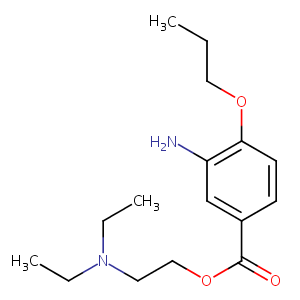Details of the Drug
General Information of Drug (ID: DMLS39E)
| Drug Name |
Proparacaine
|
||||||||||||||||||||||
|---|---|---|---|---|---|---|---|---|---|---|---|---|---|---|---|---|---|---|---|---|---|---|---|
| Synonyms |
Alcaine; Diocaine; Kainair; Ophthaine; Ophthetic; Paracaine; Prossimetacaina; Proximetacaina; Proximetacainum; Proxymetacaine; Proxymetacainum; Prossimetacaina [DCIT]; Proxymetacaine Hcl; Ak-taine; Alcaine (TN); Ocu-Caine; Proximetacaina [INN-Spanish]; Proxymetacaine (INN); Proxymetacaine [INN:BAN]; Proxymetacainum [INN-Latin]; Spectro-Caine; Ak-Taine (TN); Beta-(Diethylamino)ethyl 4-n-propoxybenzoate; BENZOIC ACID, 3-AMINO-4-PROPOXY-, 2-(DIETHYLAMINO)ETHYL ESTER; 2-(Diethylamino)ethyl 3-amino-4-propoxybenzoate; 2-diethylaminoethyl 3-amino-4-propoxybenzoate; 3-Amino-4-propoxybenzoic acid 2-(diethylamino)ethyl ester
|
||||||||||||||||||||||
| Indication |
|
||||||||||||||||||||||
| Therapeutic Class |
Anesthetics
|
||||||||||||||||||||||
| Drug Type |
Small molecular drug
|
||||||||||||||||||||||
| Structure |
 |
||||||||||||||||||||||
| 3D MOL | 2D MOL | ||||||||||||||||||||||
| #Ro5 Violations (Lipinski): 0 | Molecular Weight (mw) | 294.39 | |||||||||||||||||||||
| Logarithm of the Partition Coefficient (xlogp) | 2.7 | ||||||||||||||||||||||
| Rotatable Bond Count (rotbonds) | 10 | ||||||||||||||||||||||
| Hydrogen Bond Donor Count (hbonddonor) | 1 | ||||||||||||||||||||||
| Hydrogen Bond Acceptor Count (hbondacc) | 5 | ||||||||||||||||||||||
| ADMET Property | |||||||||||||||||||||||
| Chemical Identifiers |
|
||||||||||||||||||||||
| Cross-matching ID | |||||||||||||||||||||||
| Combinatorial Drugs (CBD) | Click to Jump to the Detailed CBD Information of This Drug | ||||||||||||||||||||||
Molecular Interaction Atlas of This Drug
 Drug Therapeutic Target (DTT) |
|
||||||||||||||||||||||||||
|---|---|---|---|---|---|---|---|---|---|---|---|---|---|---|---|---|---|---|---|---|---|---|---|---|---|---|---|
| Molecular Interaction Atlas (MIA) | |||||||||||||||||||||||||||
Molecular Expression Atlas of This Drug
| The Studied Disease | Anaesthesia | |||||||||||||||||||||||
|---|---|---|---|---|---|---|---|---|---|---|---|---|---|---|---|---|---|---|---|---|---|---|---|---|
| ICD Disease Classification | 9A78.6 | |||||||||||||||||||||||
|
||||||||||||||||||||||||
| Molecular Expression Atlas (MEA) | ||||||||||||||||||||||||
References
